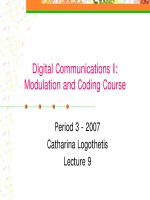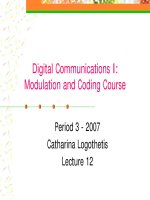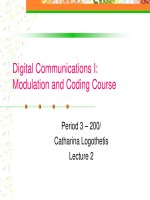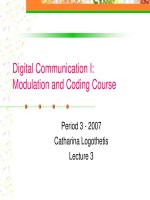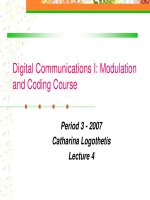Digital Communication I: Modulation and Coding Course-Lecture 13 ppt
Bạn đang xem bản rút gọn của tài liệu. Xem và tải ngay bản đầy đủ của tài liệu tại đây (315.32 KB, 36 trang )
Digital Communications I:
Modulation and Coding Course
Term 3 - 2008
Catharina Logothetis
Lecture 13
Lecture 13 2
Last time, we talked about:
The properties of Convolutional codes.
We introduced interleaving as a means to combat
bursty errors by making the channel seem
uncorrelated.
We also studied “Concatenated codes” that simply
consist of inner and outer codes. They can provide
the required performance at a lower complexity.
Lecture 13 3
Today, we are going to talk about:
Shannon limit
Comparison of different modulation schemes
Trade-off between modulation and coding
Lecture 13 4
Goals in designing a DCS
Goals:
Maximizing the transmission bit rate
Minimizing probability of bit error
Minimizing the required power
Minimizing required system bandwidth
Maximizing system utilization
Minimize system complexity
Lecture 13 5
Error probability plane
(example for coherent MPSK and MFSK)
[dB] /
0
NE
b
[dB] /
0
NE
b
Bit error probability
M-PSK
M-FSK
k=1,2
k=3
k=4
k=5
k=5
k=4
k=2
k=1
bandwidth-efficient
power-efficient
Lecture 13 6
Limitations in designing a DCS
Limitations:
The Nyquist theoretical minimum bandwidth requirement
The Shannon-Hartley capacity theorem (and the Shannon limit)
Government regulations
Technological limitations
Other system requirements (e.g satellite orbits)
Lecture 13 7
Nyquist minimum bandwidth requirement
The theoretical minimum bandwidth needed for
baseband transmission of R
s
symbols per second is
R
s
/2 hertz.
T2
1
T2
1−
T
)( fH
f
t
)/sinc()( Ttth =
1
0
T
T2
T−
T2−
0
Lecture 13 8
Shannon limit
Channel capacity: The maximum data rate at
which error-free communication over the channel is
performed.
Channel capacity of AWGV channel (Shannon-
Hartley capacity theorem):
][bits/s1log
2
+=
N
S
WC
power noise Average :[Watt]
power signal received Average :]Watt[
Bandwidth :]Hz[
0
WNN
CES
W
b
=
=
Lecture 13 9
Shannon limit …
The Shannon theorem puts a limit on the transmission
data rate, not on the error probability:
Theoretically possible to transmit information at any rate , with
an arbitrary small error probability by using a sufficiently complicated
coding scheme
For an information rate , it is not possible to find a code that
can achieve an arbitrary small error probability.
CR
b
≤
b
R
CR
b
>
Lecture 13 10
Shannon limit …
C/W [bits/s/Hz]
SNR [bits/s/Hz]
Practical region
Unattainable
region
Lecture 13 11
Shannon limit …
There exists a limiting value of below which there can
be no error-free communication at any information rate.
By increasing the bandwidth alone, the capacity can not be
increased to any desired value.
+=
W
C
N
E
W
C
b
0
2
1log
=
=
+=
WNN
CES
N
S
WC
b
0
2
1log
[dB] 6.1693.0
log
1
:get we,0or As
20
−≈=→
→∞→
eN
E
W
C
W
b
0
/ NE
b
Shannon limit
Lecture 13 12
Shannon limit …
[dB] /
0
NE
b
W/C [Hz/bits/s]
Practical region
Unattainable
region
-1.6 [dB]
Lecture 13 13
Bandwidth efficiency plane
R<C
Practical region
R>C
Unattainable region
R/W [bits/s/Hz]
Bandwidth limited
Power limited
R=C
Shannon limit
MPSK
MQAM
MFSK
5
10
−
=
B
P
M=2
M=4
M=8
M=16
M=64
M=256
M=2M=4
M=8
M=16
[dB] /
0
NE
b
Lecture 13 14
Power and bandwidth limited systems
Two major communication resources:
Transmit power and channel bandwidth
In many communication systems, one of
these resources is more precious than the
other. Hence, systems can be classified as:
Power-limited systems:
save power at the expense of bandwidth (for example by
using coding schemes)
Bandwidth-limited systems:
save bandwidth at the expense of power (for example by
using spectrally efficient modulation schemes)
Lecture 13 15
M-ary signaling
Bandwidth efficiency:
Assuming Nyquist (ideal rectangular) filtering at baseband,
the required passband bandwidth is:
M-PSK and M-QAM (bandwidth-limited systems)
Bandwidth efficiency increases as M increases.
MFSK (power-limited systems)
Bandwidth efficiency decreases as M increases.
][bits/s/Hz
1log
2
bs
b
WTWT
M
W
R
==
[Hz] /1
ss
RTW ==
][bits/s/Hz log/
2
MWR
b
=
][bits/s/Hz /log/
2
MMWR
b
=
Lecture 13 16
Design example of uncoded systems
Design goals:
1. The bit error probability at the modulator output must meet the
system error requirement.
2. The transmission bandwidth must not exceed the available
channel bandwidth.
M-ary
modulator
M-ary
demodulator
][symbols/s
log
2
M
R
R
s
=
[bits/s] R
s
sbr
R
N
E
R
N
E
N
P
000
==
[ ]
)( ,)(
0
MPgP
N
E
fMP
EB
s
E
=
=
Input
Output
Lecture 13 17
Design example of uncoded systems …
Choose a modulation scheme that meets the following
system requirements:
5
0
10 [bits/s] 9600 [dB.Hz] 53
[Hz] 4000 with channel AWGNAn
−
≤==
=
Bb
r
C
PR
N
P
W
[ ]
56
2
5
0
0
2
0
2
0
2
10103.7
log
)(
102.2)/sin(/22)8(
67.62
1
)(log)(log
[Hz] 4000 [sym/s] 32003/9600log/8
modulationMPSK channel limited-Band
−−
−
<×=≈
×=≈=
===
=<===⇒=
⇒⇒>
M
MP
P
MNEQMP
RN
P
M
N
E
M
N
E
WMRRM
WR
E
B
sE
b
rbs
Cbs
Cb
π
Lecture 13 18
Choose a modulation scheme that meets the following
system requirements:
5
0
10 [bits/s] 9600 [dB.Hz] 48
[kHz] 45 with channel AWGNAn
−
≤==
=
Bb
r
C
PR
N
P
W
56
1
5
0
0
2
0
2
0
2
0
00
10103.7)(
12
2
104.1
2
exp
2
1
)16(
44.26
1
)(log)(log
[kHz] 45 [ksym/s] 4.384/960016)/(log16
MFSK channel limited-power / small relatively and
[dB] 2.861.6
1
−−
−
−
<×=
−
≈⇒×=
−
−
≤=
===
=<=×===⇒=
⇒⇒<
===
MPP
N
EM
MP
RN
P
M
N
E
M
N
E
WMMRMRWM
NEWR
RN
P
N
E
E
k
k
B
s
E
b
rbs
Cbs
bCb
b
r
b
Design example of uncoded systems …
Lecture 13 19
Design example of coded systems
Design goals:
1. The bit error probability at the decoder output must meet the
system error requirement.
2. The rate of the code must not expand the required transmission
bandwidth beyond the available channel bandwidth.
3. The code should be as simple as possible. Generally, the shorter
the code, the simpler will be its implementation.
M-ary
modulator
M-ary
demodulator
][symbols/s
log
2
M
R
R
s
=
[bits/s] R
s
s
c
cbr
R
N
E
R
N
E
R
N
E
N
P
0000
===
[ ]
)( ,)(
0
MPgp
N
E
fMP
Ec
s
E
=
=
Input
Output
Encoder
Decoder
[bits/s] R
k
n
R
c
=
)(
cB
pfP =
Lecture 13 20
Design example of coded systems …
Choose a modulation/coding scheme that meets the following
system requirements:
The requirements are similar to the bandwidth-limited uncoded
system, except that the target bit error probability is much lower.
9
0
10 [bits/s] 9600 [dB.Hz] 53
[Hz] 4000 with channel AWGNAn
−
≤==
=
Bb
r
C
PR
N
P
W
system limited-power :enough lowNot 10103.7
log
)(
400032003/9600log/8
modulationMPSK channel limited-Band
96
2
2
⇒>×=≈
<===⇒=
⇒⇒>
−−
M
MP
P
MRRM
WR
E
B
bs
Cb
Lecture 13 21
Design example of coded systems
Using 8-PSK, satisfies the bandwidth constraint, but
not the bit error probability constraint. Much higher
power is required for uncoded 8-PSK.
The solution is to use channel coding (block codes or
convolutional codes) to save the power at the expense
of bandwidth while meeting the target bit error
probability.
dB 1610
0
9
≥
⇒≤
−
uncoded
b
B
N
E
P
Lecture 13 22
Design example of coded systems
For simplicity, we use BCH codes.
The required coding gain is:
The maximum allowed bandwidth expansion due to coding is:
The current bandwidth of uncoded 8-PSK can be expanded by
still 25% to remain below the channel bandwidth.
Among the BCH codes, we choose the one which provides the
required coding gain and bandwidth expansion with minimum
amount of redundancy.
dB 8.22.1316)dB()dB()dB(
00
=−=
−
=
coded
c
uncoded
b
N
E
N
E
G
25.14000
3
9600
loglog
22
≤⇒≤
⇒≤
==
k
n
k
n
W
M
R
k
n
M
R
R
C
b
s
Lecture 13 23
Design example of coded systems …
Bandwidth compatible BCH codes
0.41.33106127
4.36.22113127
2.27.11120127
2.36.225163
2.28.115763
0.28.112631
1010
95 −−
==
BB
PPtkn
Coding gain in dB with MPSK
Lecture 13 24
Design example of coded systems …
Examine that the combination of 8-PSK and (63,51)
BCH codes meets the requirements:
[Hz] 4000[sym/s] 3953
3
9600
51
63
log
2
=<=
=
=
C
b
s
W
M
R
k
n
R
910
1
5
4
2
4
000
10102.1)1(
1
104
3
102.1
log
)(
102.1sin
2
2)( 47.50
1
−−−
+=
−
−
−
<×≈−
≈
×=
×
=≈
×=
≈⇒==
∑
jn
c
j
c
n
tj
B
E
c
s
E
s
r
s
pp
j
n
j
n
P
M
MP
p
MN
E
QMP
RN
P
N
E
π
Lecture 13 25
Effects of error-correcting codes on error
performance
Error-correcting codes at fixed SNR influence
the error performance in two ways:
1. Improving effect:
The larger the redundancy, the greater the error-
correction capability
2. Degrading effect:
Energy reduction per channel symbol or coded bits for
real-time applications due to faster signaling.
The degrading effect vanishes for non-real time
applications when delay is tolerable, since the
channel symbol energy is not reduced.


